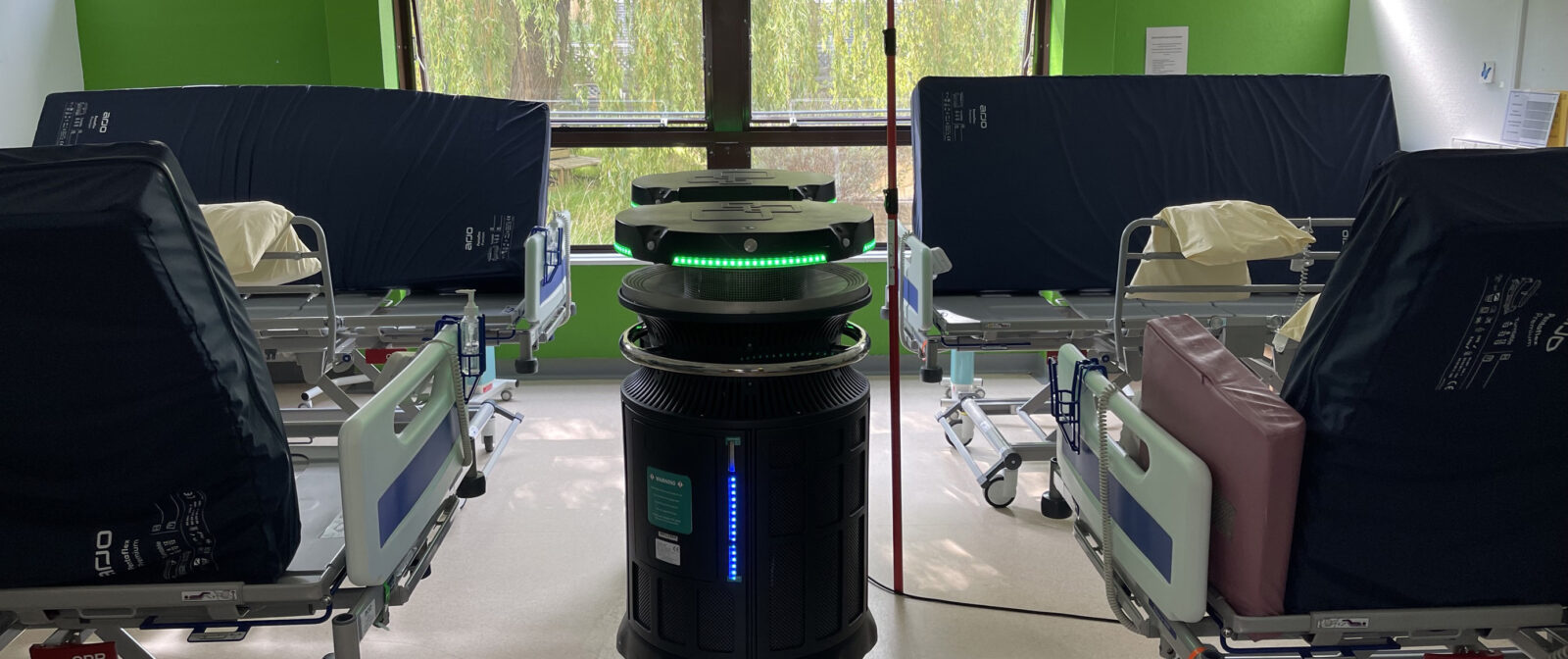
Hydrogen peroxide is a well-known and widely used decontaminating agent. Despite many studies have been evaluating the mode of action for hydrogen peroxide, there has been much debate whether the liquid phase or the gaseous phase is more efficient in killing microorganisms. Hydrogen Peroxide (H2O2) is a highly reactive oxidising agent that falls in the category of reactive oxygen species (ROS). Chemically, hydrogen peroxide removes (steals) electrons from other reactants during a redox reaction and gain those electrons to become itself reduced. It is a potent oxidant of lipids, proteins, and nucleic acids yielding high concentrations of hydroxyl radicals. Therefore, it can interact with the macromolecular components of microorganisms (i.e. surface lipids and sugars, amino acids, nucleic acids and bases, essential enzymes, etc.). Its relatively low molecular weight enables it to pass through cell walls/membranes and to interact with the internal material of microbial cells.
Hydrogen peroxide vapour (HPV) is a rapid bio-decontamination technology. Hydrogen Peroxide Vapour is produced by the various vaporisation technologies using liquid hydrogen peroxide solution to give a mixture of HPV and water vapor. Its advantage over other gaseous technologies is that it decomposes to water and oxygen, which is consider safe and so-termed residue free. Above the saturation point (dew point), Hydrogen peroxide vapor starts to condense as a liquid on surfaces.
Does hydrogen peroxide work?
Hospital environment are now becoming more and more reliant on hydrogen peroxide delivery systems to perform whole room decontamination.
Decontamination systems using hydrogen peroxide have been implemented as part of many National Trusts hospitals cleaning regime. With increased pressure on maintaining safe environments, hydrogen peroxide has proved to be vey effective in decontaminating hospital rooms.

Hard to reach areas also benefits from hydrogen peroxide decontamination. A study conducted inside hospital looking at curtains placed around patient beds and infrequently replaced (every 3–6 months), which may represent a reservoir for healthcare pathogens such as MRSA, VRE, Clostridium difficile, or other MDR bacteria. In the study, carried out in 37 hospital rooms, the use of HPV reduced the curtains’ microbial load (97%), proving to be a useful method for the decontamination of critical surfaces such as the curtains. These findings can support the idea of hydrogen peroxide molecular interaction with the microbes.
So how does it work?
Several studies demonstrated the most recognised mode of action is due to breakage in nucleic acids and by oxidation of proteins and lipids.
The main train of thoughts on hydrogen peroxide mode of action is linked to DNA strand breaks. Experiment have been designed of exposing E. coli strain W3110 to 1mM HP in phosphate buffer for 10 minutes at 25°C. It was found that this remedy produced 153-single strand breaks per genome. Similar outcomes were reported by using the same strain but with higher concentration of H2O2, 117 mM, at 37°C. It was reported that 482-single strand breaks per genome after treatment. Further investigation was performed by exposing both exponential- and stationary-phase E. coli strain TG1 cultures to 10 mM H2O2 in LB broth for 10 minutes at room temperature. DNA damage was then assessed using a diffusion assay, and 100% of nucleoids in both stationary and exponential phases were found to show ‘extensively fragmented DNA’, compared with 0.4% and 37.6% of untreated exponential- and stationary-phase cultures, respectively. They therefore concluded that exposure to H2O2 causes substantially more damage to DNA leading to mutagenesis and eventually cell death.

Many studies have been performed on the interactions with lipids, proteins and cellular membranes. Studies of the effect of hydrogen peroxide on bacterial cell membranes are also limited. E. coli cells were exposed to mode-1 and mode-2 concentrations of H2O2 and studied effects on cell morphology and the cell membrane. They found that low concentrations (1.75 mM), producing mode-1 effects, caused extensive cell filamentation, but that this change in morphology did not occur at higher (17.5 mM) H2O2 concentrations; instead a large decrease in cell volume was observed. Compared with DNA damage, oxidation of other bacterial cell components by H2O2 is far less studied, though evidence exists of damage to both proteins and the cell membrane.
A final example is the Fenton-like germicidal activity. The activity of hydrogen peroxide was tested against Staphylococcus aureus grown overnight with increased iron levels. They found that cells with increased iron concentration had greater susceptibility to hydrogen peroxide, as measured by a decrease in the hydrogen peroxide concentration required to kill 50% of cells after a 60 min exposure. The reaction between H2O2 and Fe2+ appear to produce highly toxic hydroxyl radical (OH) which may be the main cause of death of hydrogen peroxide exposed S. aureus cultures.
Does HPV processes (gas vs liquid) influence efficacy?
It is clear that many variables are contributing to the antimicrobial properties of hydrogen peroxide. In fact, different studies have reported differences in efficacy using different phases of hydrogen peroxide. It is important to mention that the technology that delivers hydrogen peroxide and how it delivers it seem to also play a fundamental role in efficacy.
According to a recently published study, condensation is highest at the lowest operating temperature, and these demonstrated the fastest kill rate. Published papers on hydrogen peroxide solutions state that spores are killed extremely as a result of direct interaction with the microbes. Suggesting that liquid-phase is far more superior than gas-phase because of higher hydrogen peroxide concentrations. Logically, whether hydrogen peroxide was in liquid or gas phase, interactions with microbes would still occur on a molecular level. Also the investigated experiments did not determine phase or concentration measurements associated with occurred condensation. Therefore, it is challenging to conclude that liquid-phase is more superior than gas-phase.
Summary
In summary, the efficacy of HPV decontamination on a wide variety of microorganisms has been reported numerous times at various concentrations and proved to inactivate highly transmitted viruses such as Rhinovirus and Influenza virus. HPV has been shown effective at whole room decontaminations and the decontamination of inaccessible areas such. However, it was shown that lower concentrations of hydrogen peroxide highly damaged the genome of E. coli, whilst higher concentrations reduce the amount of such damage. Hydrogen peroxide has different mode of action of which it leads to the elimination of the microbes, these mechanisms include direct DNA damage, chemical interactions with lipids and cellular membranes, interactions with proteins and essential enzymes, and more importantly its interactions with nucleic acids. Moreover, the different gas/liquid phase also play a role on how the efficacy is achieved in the contaminated area. With gas phase being more active and able to reach into hard-to-reach areas (i.e. hospital curtains). However, condensation into the liquid-phase was reported to contribute to higher efficacy as a result of direct interactions and higher concentration of hydrogen peroxide. Theoretically speaking, microbial interaction would still occur on a molecular level whether hydrogen peroxide is in gas or liquid form. Ultimately the injection technology will critically play a role in delivering hydrogen peroxide and in turn in the efficacy of the system. More studies are needed to elucidate the differences between the two phases and the role played by the injection technology to fully understand the full process and to determine the level of lethality.
Question: Are decontamination systems capable of maintaining the same phase of the gas throughout the decontamination cycle? If we assume that eventually hydrogen peroxide will condense on the surface, how quickly does it deposit? Is a higher concentration of hydrogen peroxide (30-35% as described in many standards) needed or is it overcompensating for a poor delivery system?





